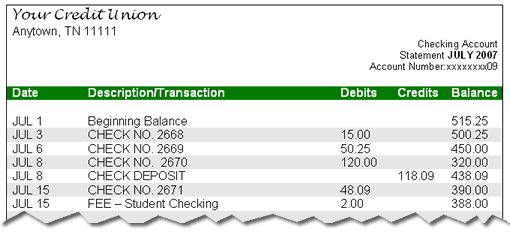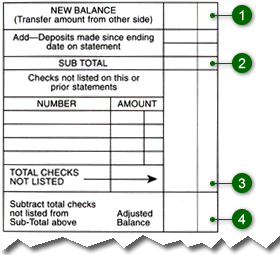You can use your statement to reconcile, or balance, your account. Many people call this balancing your checkbook. This means that you’ll see how much you deposited into your account, how much you spent, and how much you have left.
The easiest way to do this is to use a computerized program. Of course, if you want to learn the math behind the program, or you just want to understand the balancing process, then follow the steps below!
Here is what your statement might look like:

To reconcile your account look at your check register and your statement together and compare them. Here's what to do:
- If your credit union returns your checks to you, put them in order according to the check number.
- Look at the statement; find the first check number listed.
- Look at your check register. Find that same check number and place a check mark in the column labeled Code. Do this for every check on your statement. If you see checks in your check register that are not listed on the statement, then they have not cleared the financial institution yet. Don't check them off. These outstanding checks will be listed on a future statement.
- Now, just as you did with the checks, look at the statement again and find the first deposit listed. Now look at your check register and place a check mark in the column labeled Code for every deposit on your statement.
- Look to see if you have any other service fees or charges, for checks, ATM withdrawals, credit union services, or automatic deductions (a car loan, for example) listed on your statement. Also check to see if your credit union pays interest on your checking account, if so, the interest amount must be added to your check register.
- Enter the fee or interest amounts in your check register. Remember to add to or subtract these amounts from your balance.
Now your checkbook should be up-to-date. Many times your checkbook balance and the statement won't match, but that's normal. This happens because of any outstanding checks and any deposits that you made after the statement was printed.
Next go to the reconciliation form; this is usually on the back of the statement. This is a form to help you balance your account.
 |
Enter the balance from the other side of the statement on Line 1. List any deposits (money added to your account) that you recorded in your check register but which do not appear on the statement. Add those to the balance. This sum is the subtotal that you enter on Line 2. List the checks, withdrawals, etc., (money subtracted from your account) that you recorded in your check register but which do not appear on the statement. Add up the amounts of those and place the sum on Line 3. Subtract Line 3 from Line 2. Record that amount on Line 4. This is your adjusted balance. |
Now the balance of your checkbook should match the adjusted balance on your reconciliation form. If the amounts match, you're done!
If the amounts don't match, calculate the difference. Review your statement and check register to see if there is an item of the same amount that may have been missed or double counted. If you still don't match, go back to where you balanced last month and use a calculator to check your adding and subtracting. If you still have trouble reconciling your account, just call the member service number listed on your statement for assistance.
« Return to "Checking Accounts"
